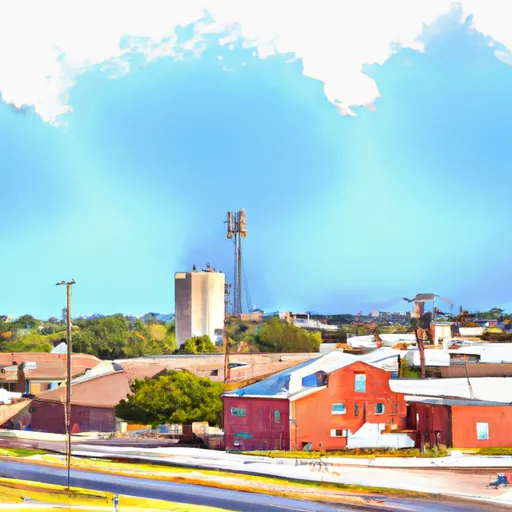-
 Snoflo Premium
Snoflo Premium
Get unlimited access to all our content
With no Ad interruptions! - Start Your Free Trial Login with existing account
Windthorst
Eden Index
Climate
9.7
•
Recreation
3.5
•
Community
2.5
•
Safeguard
5.7/10

Windthorst, Texas is a small town located in Archer County. The climate in Windthorst is categorized as humid subtropical, with hot summers and mild winters. Summers are typically hot, with temperatures often exceeding 90°F, while winters are relatively mild, with temperatures averaging around 50°F. The area experiences a moderate amount of rainfall throughout the year, with occasional thunderstorms during the summer months.
When it comes to hydrology constituents, Windthorst is not known for any major bodies of water. However, the town is surrounded by beautiful countryside, with rolling hills and picturesque landscapes. This makes it an ideal location for outdoor recreation enthusiasts. There are several opportunities for activities such as hiking, camping, and birdwatching in the nearby parks and natural areas. The Archer City Park, Lake Kickapoo, and Lake Wichita are popular spots for fishing and boating. Additionally, the Windthorst Municipal Golf Course offers a scenic and challenging golfing experience for enthusiasts.
In conclusion, Windthorst, Texas boasts a humid subtropical climate, moderate rainfall, and a lack of major water bodies. However, the town's surrounding countryside provides ample opportunities for outdoor recreation, making it an attractive destination for nature lovers.
What is the Eden Index?
The Snoflo Eden Index serves as a comprehensive rating system for regions, evaluating their desirability through a holistic assessment of climate health, outdoor recreation opportunities, and natural disaster risk, acknowledging the profound impact of these factors on livability and well-being.
Climate Health Indicator (CHI): 9.7
Windthorst receives approximately
769mm of rain per year,
with humidity levels near 79%
and air temperatures averaging around
18°C.
Windthorst has a plant hardyness factor of
7, meaning
plants and agriculture in this region tend to thrive during the non-winter months.
By considering the ideal temperature range, reliable water supplies, clean air, and stable seasonal rain or snowpacks, the Climate Health Indicator (CHI) underscores the significance of a healthy climate as the foundation for quality living.
A healthy climate is paramount for ensuring a high quality of life and livability in a region, fostering both physical well-being and environmental harmony. This can be characterized by ideal temperatures, reliable access to water supplies, clean air, and consistent seasonal rain or snowpacks.
Weather Forecast
Streamflow Conditions
Red-Lake Texoma
Area Rivers
Red-Lake Texoma
Snowpack Depths
Red-Lake Texoma
Reservoir Storage Capacity
Red-Lake Texoma
Groundwater Levels
Recreational Opportunity Index (ROI): 3.5
The Recreational Opportunity Index (ROI) recognizes the value of outdoor recreational options, such as parks, hiking trails, camping sites, and fishing spots, while acknowledging that climate plays a pivotal role in ensuring the comfort and consistency of these experiences.
Access to outdoor recreational opportunities, encompassing activities such as parks, hiking, camping, and fishing, is crucial for overall well-being, and the climate plays a pivotal role in enabling and enhancing these experiences, ensuring that individuals can engage in nature-based activities comfortably and consistently.
Camping Areas
| Campground | Campsites | Reservations | Toilets | Showers | Elevation |
|---|---|---|---|---|---|
| Possum Kingdom State Park | 16 | 1,070 ft | |||
| Lake Elmer Thomas Military - Fort Sill | None | 1,394 ft | |||
| East Side - Lake Lawtonka | 35 | 1,365 ft | |||
| De Leon Community Park | None | 1,282 ft | |||
| Lake Arrowhead State Park | 71 | 952 ft | |||
| Weiser Community Park | None | 1,485 ft | |||
| Firemans City Park - Graham | 14 | 1,024 ft | |||
| Lake Eddleman City Park | 22 | 1,085 ft | |||
| Dublin City Park | 8 | 1,460 ft | |||
| Medicine Creek RV Military - Fort Sill | None | 1,138 ft |
Nearby Ski Areas
Catastrophe Safeguard Index (CSI):
The Catastrophe Safeguard Index (CSI) recognizes that natural disaster risk, encompassing floods, fires, hurricanes, and tornadoes, can drastically affect safety and the overall appeal of an area.
The level of natural disaster risk in a region significantly affects safety and the overall livability, with climate change amplifying these risks by potentially increasing the frequency and intensity of events like floods, fires, hurricanes, and tornadoes, thereby posing substantial challenges to community resilience and well-being.
Community Resilience Indicator (CRI): 2.5
The Community Resilience Indicator (CRI) recognizes that education, healthcare, and socioeconomics are crucial to the well-being of a region. The CRI acknowledges the profound impact of these elements on residents' overall quality of life. By evaluating educational resources, healthcare accessibility, and economic inclusivity, the index captures the essential aspects that contribute to a thriving community, fostering resident satisfaction, equity, and social cohesion.

